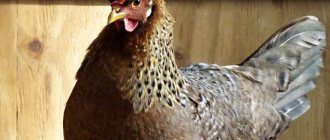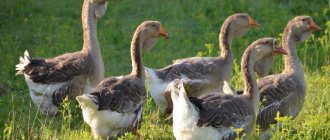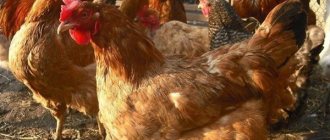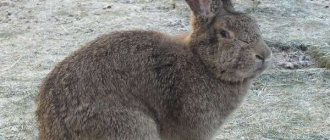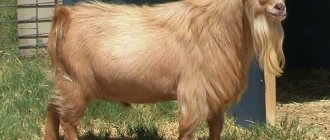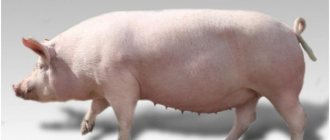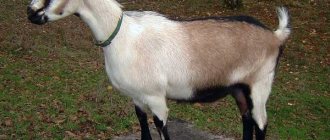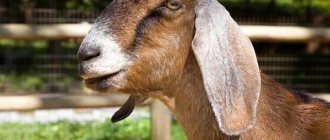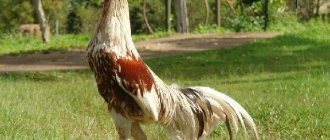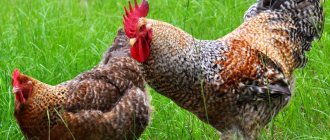Not only foreign breeders are famous for their success in the field of breeding production. Through the efforts of domestic breeders, several legendary varieties were created, among which the Oryol calico breed of chickens stands out. They are recognized all over the world for their tasty meat and beautiful appearance. Excellent adaptability to harsh climatic conditions complements this successful combination.
Orlov calico breed of chickens
Origin story
The homeland of Oryol chickens is not precisely known, but many historians are inclined to believe that representatives of this breed were brought to Russia back in the 17th century from Iran.
Count Orlov-Chesmensky played a major role in the breeding and distribution of Orlovok, thanks to whom this poultry gained enormous popularity in Russia in the 19th century.
The ancestors of birds are considered to be Malayan fighting and Persian chickens. Also, the Russian earflaps, Thuringian and Bruges breeds took a direct part in the formation of the species.
In 1899, Oryol chickens came to Western Europe, where they aroused considerable interest among the Germans and the British.
However, in the mid-20th century, many new foreign meat and egg breeds were brought to Russia.
Orlovkas turned out to be uncompetitive against them on an industrial scale and almost completely disappeared from poultry farms and private farms.
In the 50s, several enthusiastic poultry farmers decided to revive the old Russian breed and took as a basis a cross between local chickens and Orlovkas, choosing the most suitable individuals in appearance.
Selection work lasted more than 40 years, as a result the breed was restored to its original appearance.
Advantages and disadvantages
The advantages and disadvantages of the variety in question can only be assessed through comparison. Of course, against the backdrop of highly productive crosses, feathered “eagles” lose, but they have other advantages besides productivity:
- good health;
- attractive appearance;
- cold resistance;
- high viability;
- unpretentiousness.
Among the disadvantages are slightly complicated care due to their specific appearance and relatively low productivity in egg laying. Otherwise, the Oryol breed of chickens is excellent and is excellent for both small private households and for keeping on farms.
That's all that can be said about Oryol quonki. Share the material you read with your friends and like-minded people - they will also be interested.
Subscribe to the site's news and don't miss the latest publications!
Success and prosperity to you and your loved ones! Did you like our tips? Share with friends on social media. networks! See modern products for poultry and livestock farmers that improve the health of pets and make our work easier.
Description of the breed
Photo:
In recent years, the popularity of Oryol chickens has increased sharply - laying hens can be found both in small poultry farms and in the courtyards of private farms.
At the moment there are 2 branches of the breed: Russian and German. Quality standards in Germany differ from domestic ones, therefore, over many years of selection and breeding work, these majestic birds have lost their original similarity.
Orlovkas are classified as both decorative and sport-fighting breeds. Despite their powerful appearance, these birds have a friendly and calm character.
Laying hens do not have high egg production rates, but their colorful plumage and unpretentiousness in maintenance attract both domestic and foreign poultry farmers.
Oryol chickens are preserved in the gene pool collection of VNITIP.
Characteristic:
- Head. Similar to an eagle or falcon. Covered with protruding feathers forming a beard and sideburns. Thanks to its lush plumage, it is spherical. The wide forehead and brow ridges evoke associations with birds of prey.
- Neck. Oblong with luxurious plumage. A characteristic feature is that the top is decorated with a scruff. Tapers towards the base.
- Eyes. Deeply planted. They stand out against the background of overhanging arches of amber hue.
- Beak. Small in size, hooked in shape. Powerful at the base and maximally curved at the end. In pre-revolutionary times, individuals with a characteristic “cleft” were preferred.
- Scallop. Looks like a flattened and cut raspberry. Covered with small tubercles. It is located on the front of the forehead, low, almost falling on the nostrils.
- Beard. In the form of a wedge or hanging throat fold.
- Body. Wide and short, vertical orientation. With great growth, the body is elongated.
- Shoulders. Straight, inclined forward.
- Back. Short and flat, tapering noticeably at the tail.
- Wings. Middle length. They fit tightly to the body.
- Tail. Full, set at right angles along the line of the spine. The braids are small, narrow, rounded. The upper ones stand out against the background of the rest of the plumage.
- Breast. Slightly bulging forward. In males it is well muscled and well developed.
- Stomach. Neat and selected.
- Shins. Well defined, thick and long.
- Legs. Strong, yellow.
Color
The color of the plumage of poultry is very diverse. At the moment, there are the following subspecies of Oryol chickens: calico, white and black, mahogany, brick, black and red.
The most common are calico-colored individuals. They are easily distinguished by their bushy beard, consisting of white, orange and gray feathers. The body and chest of calico roosters are black with white patches, the head and back are brick-colored.
On the wings, transverse stripes of black color with a greenish tint are clearly visible. The tail is completely black, but the breed standard allows for a pair of white feathers in the upper braids.
Chickens have identical colors, but the colors are not as bright as those of roosters. There are quite a lot of white feathers on the beard and nape. The light inclusions on the body are clearly defined.
Of the monochromatic colors in our area, the most common are white Orlovkas. In private poultry yards you can also find mahogany birds, whose body and head are brick-colored, and whose tail is black with a green tint.
Character
The Oryol rooster is a real master of the poultry yard, ready to rush into battle at any moment. His appearance is full of dignity, he loves to walk around the poultry house, proudly sticking his powerful chest forward.
If you decide to get a rooster of this breed, you can be sure that no other bird will dare to encroach on the territory entrusted to it - it will give a worthy rebuff to anyone.
Orlovets inherited such a fighting character from his ancestors - the Malayan chickens. However, you should not think that roosters of this breed are pugnacious and aggressive.
They get along well with other birds in a common poultry yard, but they do not allow other roosters near them or their hens.
Laying hens are distinguished by a friendly and flexible disposition, rarely get involved in fights and calmly coexist with other birds.
Hatching instinct
Chickens of the Oryol breed are deprived of the brooding instinct. Many poultry farmers do not consider this feature a disadvantage, since there are fewer and fewer supporters of natural incubation every year.
In addition, hens do not lay eggs during the incubation period, which is not economically profitable.
How to choose a purebred bird?
Purebred Oryol chicken must fully comply with the approved standard. A breed defect can be determined by:
- underdeveloped plumage on the head;
- the presence of a hump;
- small stature of the bird;
- insufficient weight for age;
- narrow back and chest;
- the presence of residual feathering on the toes and metatarsals;
- brownish body color;
- black beard;
- straight thin beak.
It is not worth purchasing such birds, as they will not correspond to the characteristics of the breed and may simply disappoint you. At the moment, there are quite a lot of subsidiary farms in Russia where you can buy selective chickens and Orlovok hatchery eggs. At specialized exhibitions you can also meet collectors involved in poultry breeding, and you are guaranteed to purchase a purebred chicken.
In the video presented, the breeder talks about the Orlovskaya chicken breed:
Frequent illnesses
With proper care, Oryol chickens rarely get sick. If you do notice symptoms of illness in laying hens, you should correctly diagnose and promptly begin treatment.
The most common non-infectious diseases of Oryol chickens and methods of their treatment
| Name of the disease | Main symptoms | Treatment |
| Avitaminosis | General malaise, weight loss, loose stools, decreased egg production, pallor of the comb, lethargy. | After a blood test, the doctor will prescribe a complex of missing vitamins and minerals that will need to be added to the chicken’s food. |
| Tenosynovitis | Lameness, lethargy, refusal to eat, swelling in the joint area. | Introduction of juicy greens into the poultry diet. |
| Gout | Diarrhea, stool discoloration, impaired motor function, swollen joints, increased body temperature. | Drinking a 2% aqueous solution of bicarbonate salt, 0.25% methenamine. |
| Hydrocele of the abdominal cavity | Increase in abdominal volume, change in its shape, shortness of breath, lethargy. | In mild forms of the disease, fluid is pumped out from the abdominal cavity and diuretic therapy is performed. |
| Cloacite | Diarrhea, inflammation of the cloaca, the appearance of hemorrhagic ulcers, weight loss, lack of egg production. | Treatment of the cloaca with a 1% solution of Rivanol, lubrication with terramycin ointment, Levomekol. |
| Gastroenteritis | Depression of consciousness, blue scallop, loss of appetite, diarrhea, fever. | A diet including fermented milk products, solutions of iron sulfate 0.2%, potassium iodide 0.02%. After assessing the condition, the veterinarian may prescribe antibiotics to the bird: Tetracycline, Neomycin. |
Reviews
Poultry farmers in Siberia and other regions with harsh climates often prefer Oryol chickens, as they easily adapt to various environmental conditions without losing their productive qualities.
The advantages of the breed also include:
- decorative appearance;
- good meat productivity;
- endurance;
- unpretentiousness in content;
- high taste qualities of meat products.
This breed also has its disadvantages:
- decrease in egg production in laying hens with age;
- slow bird growth;
- late maturation of laying hens;
- poor plumage of chickens, which creates some difficulties in raising them.
Despite all the advantages, Orlovkas are not bred on an industrial scale.
At the moment, breeders have developed many meat and egg breeds with higher productivity rates.
Most often, Oryol chickens can be found in small poultry houses, where they are bred more for decorative purposes.
Where can I buy it in Russia?
Despite the fact that this breed is unpretentious in maintenance and feeding, it is hardy and very strong; it is not bred on an industrial scale.
This family belongs to rare, endangered species, so only amateur poultry farmers breed this bird. They will also introduce you to the rules of bird breeding.
The following farms are considered the most popular, where you can choose and buy chickens or hatchery eggs of Oryol breed hens:
- Kurkovo village , house 33, Moscow region, Lukhovitsky district, phone: +7 (985) 200–70-00.
- They accept orders for hatching eggs and chicks of chickens of this family at a farm in the city of Saratov , telephone number for contact.
Productivity
In comparison with the meat-egg productivity of modern chicken breeds, Oryol calico chickens are no longer considered highly productive.
Although the live weight of adult individuals reaches 5 kg, their bones are too heavy, so the meat yield after slaughter can be 50-55% (sometimes higher).
But the quality of meat products from Oryol chicken carcasses is delicious, tender with good nutritional value.
Sexual maturity in individuals of this breed occurs late - at 7-8 months. At this age, the pullets begin to lay their first eggs. The weight of one egg is 59-61 g - this is quite a high figure.
The dense, strong shell is colored in different shades of brown. In a year, one hen can lay no more than 155 eggs.
Maternal instinct in Oryol calico hens is practically not developed. And even if such a hen sits on the clutch, then in 94% of cases she will get up from the nest and simply leave. Therefore, to hatch chickens, it is recommended to purchase an incubator or lay eggs with hens of other breeds.
Why the breed attracts breeders and farmers
For breeding in the harsh Russian climate, domestic chicken breeds are the best. Chickens of the Oryol breed were successfully bred on peasant farms for meat and eggs.
Chickens of this population have many advantages. They are not afraid of frost and lay well in winter. Average egg production is 150-160 pcs., with good care - up to 200 pcs. The weight of a medium-sized egg is 58-63 g, but there are also up to 100 g. The birds are very large and produce a large yield of tasty meat of dietary quality.
Purebred chicken breeding is becoming an increasingly profitable business. This is the sale of hatching eggs, chickens, and raised poultry. More and more people are interested in natural eco-products and are concerned about healthy eating.
Breeding
To achieve success in breeding Orlovkas, it is necessary to take into account some of the nuances of this breed.
At the moment, it is quite difficult to find purebred birds that fully meet the standards.
Their breeding is mainly carried out by professional poultry farmers and participants in various bird exhibitions.
It should also be taken into account that Oryol laying hens reach maturity quite late, so there is no point in purchasing a chicken under 2 years old.
Birds that have:
- low weight for his age;
- insufficient feathering of the neck and scruff;
- thin beak;
- color inappropriate for the subspecies.
For incubation, choose large eggs of regular shape with a dense shell. They must be fresh, shelf life - no more than 5 days.
To hatch chickens, it is advisable to use special incubators with microclimate and temperature regulation.
Growing clingy
In the incubator, chickens hatch within 20-21 days. After birth, they are placed in a large box or box, at the bottom of which sawdust or hay is placed.
This type of litter needs to be changed daily. Chicks of the Oryol breed have a relatively low survival rate and require constant attention. They grow slowly and plumage appears late.
Chickens do not tolerate high humidity and cold well and are prone to colds.
Chicks do not adapt well to changes in external conditions, so in the first days of life they must be kept in a room heated to +35 degrees.
By the end of the first week, the temperature is reduced to +32. Thus, the house should be cooled a couple of degrees every week. The optimal temperature for keeping young animals is +23 degrees.
Features of keeping Oryol calico chickens
The Old Russian breed is characterized by endurance, unpretentiousness, resistance to cold and undemanding nutrition. This means that a novice poultry farmer can breed it.
Oryol calico loves conditions that are as close to natural as possible. She spends most of her time outside or walking in an enclosure. If the bird is healthy, then it can be released for a walk in the cold and rain.
Be sure to read:
Breed of chickens LAKEDANZI and UKHEILYUY - destroying myths: description of the breed, history of origin
Oryol chickens are unpretentious
How do you cope with the cold?
Usually birds are kept in a room where there is no heating, but in the northern regions it is advisable to insulate the chicken coop so that the birds feel comfortable and can go out into the enclosure.
During mild winters, walking outside is mandatory, but on frosty days this should not be done. Although Oryol calicos are well adapted to cold weather, severe frosts can reduce productivity.
Care
Basic care rules include traditional activities:
- bird feeding;
- cleaning the chicken coop;
- replacing bedding;
- checking the condition of the nests;
- inspection of eggs and their collection;
- monitoring the health of birds.
The chicken coop needs regular cleaning and changing the bedding to dry. Ventilation is important at any time of the year. Grooming also includes walking chickens. Once a year, the chicken coop is completely cleaned and disinfected. If this is not done, the birds may get sick.
Feeding and required diet
Orlov residents are undemanding when it comes to nutrition.
Orlov residents are undemanding when it comes to food; the standard diet of any breed of chicken suits them. An important condition for good growth is a variety of feeds and their balance in the main substances: proteins, fats, carbohydrates.
It is necessary to include food in the menu that is balanced in composition and nutritional value. The daily diet includes an average of 185 g of food. It is necessary that fresh grass and water be freely available.
The birds are fed twice a day and included in the menu:
- roots;
- grains of various crops, whole or crushed;
- boiled potatoes;
- dairy products;
- food waste;
- ready-made feed and feed mixtures.
In a separate feeder you need to place mineral supplements, fine gravel, and sand. There should always be clean and fresh water in drinking bowls. Provide free access to feeders.
It is important to control the body weight of the laying hen. Both excessive thinness and large weight gain are bad indicators.
Breeding
Chickens of the Orlov calico breed are excellent brood hens. They take care of the offspring and nurse the chickens. But for this you need to build the nest correctly. The nests are located at a height of 1 m above the floor. This could be a box filled with straw, sawdust, or fresh grass. The size of the nest is important so that the hen can comfortably hatch her eggs. The nest is built 0.5 m high and wide, and 10 cm deeper.
Be sure to read:
Orpington chickens: description of the breed, cultivation and care
Raising chickens
Oryol calico chickens
The characteristics of young animals include their slow growth, they may be weak-legged and crooked. The plumage forms late, so in the cold season they often get sick and die. Even with the careful attention of the owner, the survival rate is quite low.
It is important that the litter is constantly dry and the room is insulated. A significant area is allocated for young animals, since they need to move a lot and develop muscles. In warm weather, walking in the fresh air begins at 1-2 months of age.
Young birds are kept separately from adult birds. At the initial stages of growth, they require high temperatures of up to +30°C, which are gradually lowered to +20°C. The temperature regime must be monitored so that the chickens do not overheat or become hypothermic.
Feeding is carried out with boiled cereals, mash, and special feed. At the age of 2 months, chickens are transferred to adult birds.
Orlov calico chicken
Content
Oryol chickens, on the one hand, are unpretentious, and on the other hand, they require compliance with the rules of keeping.
To maintain health and a beautiful appearance, pets must feel comfortable in the house.
Birds do not require heating, since they have a high frost resistance characteristic. However, this is not an indicator of keeping poultry in a ventilated house.
The chicken coop for Oryol residents should be insulated, light and draft-free.
The fighting blood has made the chickens active, and they require significant physical activity, for which they should have a spacious range with covered areas. Birds need to walk even in winter.
Feeders and drinkers must be designed for a chicken's beak. It is curved and short and deep containers are inconvenient for them.
Nests and perches are located 1 meter above the floor. Due to the large weight of the birds, nests are made from durable wooden boxes.
The litter in the poultry house needs to be deep. It is better to make the bottom layer from straw, and the top from sawdust.
Fans of the breed ask everyone who is tired of their calico pets not to let them go to meat, but to sell them.
Having compiled a correct description of your bird, you can do this in the shortest possible time. It is expensive, and it will be much more profitable than a carcass.
Bird care is complex. To maintain the health of calico chickens, remove the top layer of litter in the barn once a month, and completely change it in the spring and late summer. After removing the old litter, you need to whitewash the walls of the poultry house and the floor with slaked lime, which is an antiseptic.
Pets should be regularly treated for parasites using special medications that can be purchased at a veterinary pharmacy. In the Moscow region, you can buy everything you need at the Orlovsky Dvorik farm.
Additional burning in the barn is required only in those regions where the temperature remains at -30 for a long time, which makes the chicken coop colder than -10.
How are Oryol roosters trained?
Males, who are bred specifically for fighting, are kept separately from the livestock. They are trained daily to develop endurance and strength. The same person must handle the bird, preferably its owner.
There are several exercises that are used to prepare for cockfighting. To increase endurance, a wheel is used in which the bird runs until it has enough strength. To strengthen the leg muscles, birds wear weights. Quite often they practice the “striking” exercise, when while the bird is moving, the owner interferes with its path using a stick or other object. The rooster must jump over the obstacle.
Attention! Trainings are carried out regularly. Their duration depends on the degree of preparation of the bird. Under no circumstances should birds be driven to complete exhaustion.
Feeding
Orlovskys belong to the general breed. There are no specific requirements for drawing up a nutrition plan.
Birds are unpretentious when it comes to filling their diet.
Tips for poultry farmers:
- Food should be varied with dairy products, various types of crushed grains, root vegetables, boiled potatoes, kitchen waste and herbs from the garden.
- Ready-made mixed feeds containing vitamin and mineral supplements and proteins in the required quantities are suitable for feeding.
- There should always be a container of fine-grained sand and gravel next to the feeders.
- The quality of water in drinking bowls is monitored daily. Stagnation must not be allowed.
- Equipment must be disinfected regularly.
- The optimal grain mixture is 30% barley, 30% wheat, 10% unprocessed buckwheat, 5% seeds and millet each, 20% corn.
- Chickens love moist mash. The approximate composition is meat and bone meal, boiled potatoes, fish and steamed barley.
In addition to the main feed, oats are suitable, especially relevant from August to October, young grass and nettles in summer, cakes and soybean meal, which are a valuable source of protein, as well as hay, carrots, cabbage and beets.
Diet
The Orlovskaya is a rather unpretentious bird in terms of diet. Therefore, there is no need to purchase special feed mixtures. Chickens can be fed standard food, in particular:
- Compound feed.
- A mixture of grains. You can prepare it yourself. You can mix sunflower seeds, wheat grains, millet, corn, etc.
- Mash-ups. Mashes occupy a very important share in the poultry diet, especially in winter. The good thing about mash is that you can add a large amount of nutritious food to their composition. Also, another advantage of mash is the ability to cook it in meat broth, which significantly increases its value for poultry.
- Fresh vegetables. These include: carrots, pumpkin, zucchini, cabbage, etc.
- Sources of calcium. They need to be given special attention if poultry is raised for the purpose of producing egg products. If there is a lack of calcium, the bird may produce eggs with thin shells or without them at all. The most popular sources of calcium are meat and bone/fish meal, food chalk, crushed shell rock, and crushed eggshells.
- Yeast. They are included in the diet when the bird is significantly behind in weight.
Diseases and their treatment
Oryol chickens are not prone to diseases at all, but there are rules of prevention that must be followed.
The lush plumage of chickens is under threat, so you need to especially carefully protect it from parasites.
The most dangerous pests are ticks and lice beetles. Pooh-eaters almost instantly deprive animals of their main advantage - their feathers.
Ticks carry dangerous infectious diseases that can become epidemic. In addition, the flock needs standard preventive vaccinations against common infectious diseases of chickens.
Shedding
Like most chickens, feathered eagles are subject to molting - seasonal renewal of plumage. The only difference is that the process takes a little longer for them due to the very abundant feather cover.
Rules for care and feeding during the molting season:
- it is important to reduce the length of daylight hours;
- provide warmth for molting individuals;
- add healthy fats to your diet;
- increase the nutritional value of the diet, enrich it with proteins;
- supplement the daily menu with vitamins and minerals.
The Oryol breed of chickens molts for about 30-40 days and during this time stops laying eggs.
During this period, there is an increased risk of the spread of viral and bacterial infections, so it is important to closely monitor the family and, if necessary, isolate the sick in a timely manner.
In addition, it is important that the poultry farmer is able to distinguish seasonal molting from parasitic infections and other diseases accompanied by feather loss.
Character
Based on genetic characteristics, it can be assumed that “eagles” have a tough temperament, since fighting blood flows in their veins. But it is not so. Roosters are a little aggressive, but they don’t attack without reason and get along quite well within their species.
The Oryol breed of chickens is not suitable for keeping together with representatives of other varieties, because this can lead to various conflicts and even losses. In general, winged beauties are very active, loud and restless. Klushi lead a more measured lifestyle, pliable and obedient.
Analogs
Malayan fighting breed
Oryol chickens are a unique family of birds. They are unique in their essence, and it is very difficult to find a replacement for this species.
If you cannot find representatives of this particular species, you can replace them with similar ones. Of course, the analogue will not be the desired copy.
Here are some representatives of the egg-laying chicken family that can compete with Oryol chickens:
- Malayan fighting. They have the same dense constitution, strong legs and slender body, well-developed bones. The lower leg muscles of both breeds are developed almost identically. The productivity and egg production of both are practically at the same level.
- Yurlovsky vocal chickens. Similar in constitution, they are also distinguished by good productivity and endurance. In addition, they have a wonderful voice, so they will delight their owners with their wonderful singing.
Productive qualities
The Oryol breed is considered a meat-egg breed. A young rooster gains weight up to 3.5 kg, and a chicken - up to 3.0 kg. Birds continue to grow even after they reach one year of age. An adult male weighs 4.5 kg, and a chicken weighs 3.5 kg. The breed is a late-ripening breed; hens lay their first eggs when they reach the age of 8 months. In the first 365 days, you can get about 180 eggs from one bird, then this figure drops to 150. The eggs are large in size and can weigh about 60 grams. The shell is dense and can be light cream or white.
Oryol chicken of variegated color
